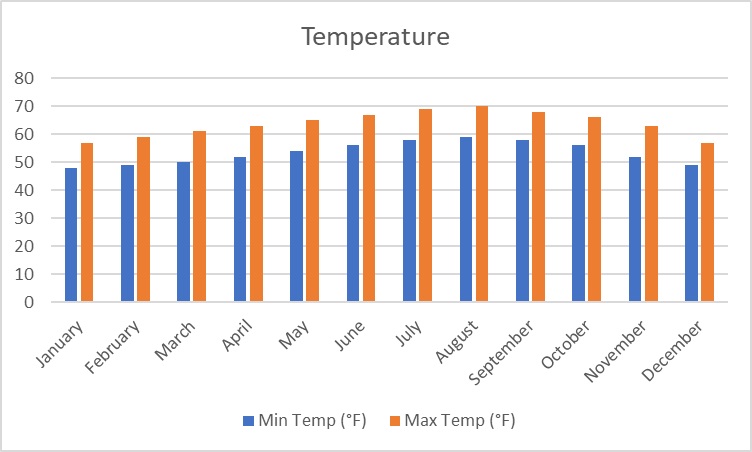This blog is your all-encompassing compass for unraveling San Francisco’s distinctive tapestry, whether you are a seasoned resident or an inquisitive explorer. Join us on a tour through the city’s weather miracles, resilience against natural events, and an in-depth investigation of local insights that truly distinguish this vibrant metropolis. Fasten your seatbelts as we travel the different landscapes and discover the stories that create San Francisco’s identity, from microclimates to seismic secrets, hidden gems to local wisdom.

San Francisco Weather Overview
San Francisco is noted for its warm and frequently foggy weather. The climate of the city is Mediterranean, with chilly, wet winters and warm, dry summers. San Francisco has an average temperature of 57 degrees Fahrenheit (14 degrees Celsius).
The city receives 22 inches of rain per year on average, with the most of it falling between November and April. San Francisco also has an average of 243 days of fog every year, with most of this occurring during the summer months.
San Francisco, despite its reputation for fog, offers a lot of sunshine. The city has 260 sunshine days per year on average.

San Francisco Weather By Month
Here is a more detailed breakdown of San Francisco’s weather year-round:
Winter (December-February)
- Average temperature: 50 degrees Fahrenheit (10 degrees Celsius)
- Rainfall: 7 inches (18 centimeters)
- Snowfall: 0 inches (0 centimeters)
- Fog: 100 days
Spring (March-May)
- Average temperature: 55 degrees Fahrenheit (13 degrees Celsius)
- Rainfall: 4 inches (10 centimeters)
- Snowfall: 0 inches (0 centimeters)
- Fog: 80 days
Summer (June-August)
- Average temperature: 63 degrees Fahrenheit (17 degrees Celsius)
- Rainfall: 1 inch (3 centimeters)
- Snowfall: 0 inches (0 centimeters)
- Fog: 50 days
Fall (September-November)
- Average temperature: 58 degrees Fahrenheit (14 degrees Celsius)
- Rainfall: 4 inches (10 centimeters)
- Snowfall: 0 inches (0 centimeters)
- Fog: 70 days
Navigating Natural Disasters in San Francisco
Can San Francisco flood?
Because San Francisco is located on a peninsula surrounded by sea, it is susceptible to flooding. The city has a history of flooding, and the risk is growing as sea levels rise due to climate change. A severe flood struck the city in 2015, causing over $1 billion in damage.
Can San Francisco have a tsunami?
Tsunamis created by earthquakes along the Cascadia Subduction Zone, which is located roughly 200 miles off the coast of Northern California, pose a threat to San Francisco. A tsunami from this area might reach San Francisco in as little as 1-2 hours. The city has a tsunami warning system in place, and evacuation preparations for coastal communities are in place.
Can San Francisco survive an earthquake?
San Francisco is situated near the San Andreas Fault, one of the world’s most active earthquake faults. A strong earthquake on the San Andreas Fault could cause severe destruction and damage in San Francisco. However, the city has taken precautions against earthquakes, such as modifying buildings to make them more durable.
Will San Francisco ever be underwater?
Climate change-induced sea-level rise might someday flood areas of San Francisco. The city is constructing seawalls and raising streets to protect itself from increasing sea levels. If sea levels continue to rise at their current rates, some portions of the city may be submerged by the end of the century.
San Francisco tsunami likely score
San Francisco has a tsunami likelihood score of 6.8, indicating that there is a 68% possibility of a tsunami occurring in the city during the next 50 years. This is a pretty high risk; thus, inhabitants should be aware of the tsunami warning system and evacuation procedures.
San Francisco smells like poop
San Francisco has a lengthy history of odor issues. The city’s sewage infrastructure is ancient and overburdened, and it frequently discharges raw sewage into the Bay. This sewage can emit a strong stink, particularly at low tide. Furthermore, San Francisco has a big homeless population, which might contribute to the stink issue.
Local Insights
San Francisco, a dynamic city located among Northern California’s gorgeous surroundings, entices with its rich history, intriguing culture, and spectacular natural beauty. From its iconic Golden Gate Bridge and quaint cable cars to its numerous neighborhoods and world-class culinary scene, San Francisco provides visitors and residents with an unending assortment of experiences. Whether you are a frequent visitor or a curious novice, navigating San Francisco’s complexities can be a fascinating and satisfying experience.
Here are a few of the many features that distinguish San Francisco:
- San Francisco Area Code: 415
- San Francisco, CA: A city located in Northern California, United States.
- San Francisco Craigslist: An online marketplace for goods, services, jobs, and housing in San Francisco.
- San Francisco Coffee Festival: An annual event celebrating coffee culture and showcasing local roasters.
- San Francisco DMV: The California Department of Motor Vehicles office in San Francisco.
- San Francisco de los Tejas: The original name of San Francisco, given by Spanish explorers in the 18th century.
- San Francisco Demographics: Statistical data on the city’s population, including age, ethnicity, and income.
- San Francisco District Attorney: The chief prosecutor for San Francisco County.
- San Francisco de Asis Santo: Saint Francis of Assisi, the patron saint of San Francisco.
- San Francisco Hills: Top 7 hills that make up the city’s topography.
- San Francisco Bridge: The Golden Gate Bridge, an iconic landmark of the city.
- San Francisco Bay: A large natural body of water that surrounds the city.
- San Francisco Islands: A group of islands located in San Francisco Bay.
- San Francisco Nearby Cities: Nearby cities to San Francisco, such as Oakland, San Jose, and Berkeley.
- San Francisco Near Airport: San Francisco International Airport (SFO).
- San Francisco Nearby National Parks: Golden Gate National.
- San Francisco Island: San Francisco is not an island.
- San Francisco is in What County: San Francisco is a consolidated city and county, so it does not belong to any specific county.
- San Francisco is in What State: San Francisco is in the state of California.
- San Francisco Israel Consulate: Yes, San Francisco has a consulate for Israel.
- San Francisco Nearby Cities: Some nearby cities to San Francisco include Oakland, Berkeley, and San Jose.
- San Francisco Near Airport: San Francisco International Airport (SFO) is the main airport serving the city.
- San Francisco Nearby National Parks: Some nearby national parks include Muir Woods National Monument and Point Reyes National Seashore.
- San Francisco Near Ocean: Yes, San Francisco is located along the Pacific Ocean.
- San Francisco Near Puerto Vallarta: Puerto Vallarta is not near San Francisco; it is in Mexico.
- San Francisco Near Beach: San Francisco has several beaches, including Ocean Beach and Baker Beach.
- San Francisco to Los Angeles: The distance from San Francisco to Los Angeles is approximately 380 miles.
- San Francisco to Yosemite: The distance from San Francisco to Yosemite National Park is approximately 170 miles.
- San Francisco Skyline: The panoramic view of the city’s skyline, including skyscrapers and landmarks.
- San Francisco Zoo: A popular attraction with a diverse collection of animals.
- San Francisco Zoo Tickets: Admission tickets to the San Francisco Zoo.
- San Francisco is in What County: San Francisco County.
Commonly Asked Questions
Q: Where do San Francisco cable cars travel?
A: San Francisco cable cars traverse various routes, including Powell-Hyde, Powell-Mason, and California Street lines, providing scenic views and a nostalgic experience.
Q: Where can homeless populations be found in San Francisco?
A: Homeless populations in San Francisco are dispersed throughout the city, with notable concentrations in areas like the Tenderloin district and around downtown.
Q: Has San Francisco experienced fires, and where have they occurred?
A: Yes, San Francisco has experienced fires in different locations over the years, with incidents occurring in residential and business areas.
Q: Where do protests commonly take place in San Francisco?
A: Protests in San Francisco can take place at various locations, often centered around civic and public spaces like Civic Center Plaza or City Hall.
Q: Where are fireworks displays held in San Francisco?
A: Fireworks displays in San Francisco are commonly held at iconic locations such as the Embarcadero or Fisherman’s Wharf, especially during celebratory events like the Fourth of July.
Q: Where are the San Francisco Peaks located?
A: The San Francisco Peaks, a volcanic mountain range, are not in San Francisco. They are in northern Arizona near Flagstaff.
Q: What about the San Francisco Giants’ standings?
A: The San Francisco Giants’ standings can change during the baseball season. Checking sports news websites or the official MLB standings would provide current information.
Q: Where are the San Francisco 49ers based?
A: The San Francisco 49ers are based in Santa Clara, California, playing their home games at Levi’s Stadium.
Q: Where is San Francisco situated?
A: San Francisco is located on the northern tip of the San Francisco Peninsula in northern California.
Q: What are the coordinates for San Francisco on the map?
A: On the map, San Francisco is situated at the coordinates 37.7749° N latitude and 122.4194° W longitude.
Q: Where is San Francisco Bay?
A: San Francisco Bay is a prominent body of water surrounding the city, connecting to the Pacific Ocean.
Q: In which state is San Francisco located?
A: San Francisco is in the state of California on the west coast of the United States.
Q: Where was San Francisco de los Tejas historically located?
A: San Francisco de los Tejas was a mission in Spanish Texas, historically located near present-day Weches, Texas.
Q: Where is San Francisco Bay located?
A: San Francisco Bay is located along the western coast of California, forming a natural harbor.
Q: Where is San Francisco State University situated?
A: San Francisco State University is situated in San Francisco, California, near Lake Merced.
Q: Where is the historical site of San Francisco de los Tejas located?
A: The historical site of San Francisco de los Tejas is located near the present-day Weches, Texas.
Q: Where is San Francisco located in California?
A: San Francisco is in northern California, surrounded by the Pacific Ocean and the San Francisco Bay.
Q: Where can one find “Where San Francisco” magazine?
A: “Where San Francisco” magazine is an exploratory publication focusing on various aspects of the city, from culture to lifestyle.

Viswanath Alikonda (Viswa) is a techie, passionate traveler, writer, and adventurer who believes that life is best experienced through the exploration of new places and cultures. With a deep love for adventure and a curiosity that knows no bounds, Viswa has embarked on journeys to various corners of the globe, from the New York to Bay Area.
His travel experiences have not only broadened his horizons but have also given him the opportunity to share stories, insights, and travel tips with a global audience. Viswa’s travel blogs aim to inspire fellow wanderers, offering a glimpse into the beauty of our world and providing practical advice for planning unforgettable adventures.
